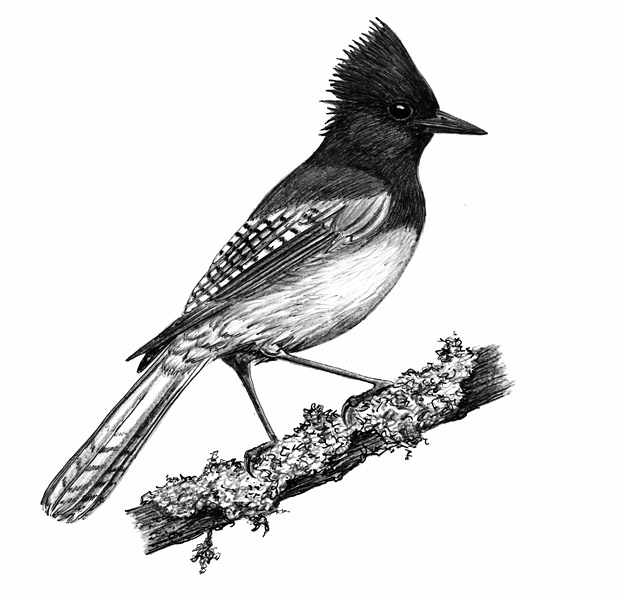
Dear Bird Folks,
I’ve just returned from visiting my sister on the West Coast. While I was out there, I saw a number of cool new birds. One bird in particular caught my eye. For obvious reasons I became interested in the Stella’s Jay. Are they closely related to our Blue Jay?
– Stella, Rome, NY
Hey, Stella!
Are you sure you aren’t from eastern Massachusetts? You have the same pronunciation problems I have. I wish the English language never used the letter “r” at the end of words. That letter has caused me to flunk more than one spelling test. Why am I talking about this? No disrespect to your name, but the bird you saw is a “Steller’s” Jay, not “Stella’s” Jay. I know, those two words sound exactly the same to me, too, but it seems the rest of the world hears and spells them differently. Maybe someday they’ll name a bird after you, Stella, but I’m sorry to say it is not this bird. Wait until you hear who it’s named after… somebody none of us have ever heard of.
The Steller’s Jay is named after Georg Wilhelm Steller, a self-centered eighteenth century naturalist who named every creature he discovered after himself. In addition to this jay, he attached his name to the Steller’s Sea Eagle, Steller’s Eider and the Steller’s Sea Lion. He also named the Steller’s Sea Cow, a slow moving, cold weather relative of the manatee. Unfortunately, the ill-fated Steller’s Sea Cow had several survival flaws. It had no teeth for protection and it lived near the water’s surface, but it didn’t have the ability to dive to escape danger. But its two most damaging faults were that it had zero fear of humans and it tasted delicious. That’s a bad combination. Only twenty-seven short years after Georg Wilhelm discovered it, hungry sailors ate the Steller’s Sea Cow into extinction. In fact, the Steller name is a bit of a jinx. Most of the creatures he gave his name to are either extinct, threatened or endangered. The only one holding its own is your semi-namesake, the Steller’s Jay.
From a distance Steller’s Jays look like a cross between their cousins the Blue Jay and a crow. It has a black upper-body, with a blue lower half. The birds wear Blue Jay style head-crests that are often rather saggy, making them look as if they’ve just rolled out of bed. They have harsh scolding calls and are every bit as noisy as you’d expect a jay to be. Historically, Steller’s Jays favored the upper branches of tall, dense conifers. But in recent years they have learned to come to local parks for scraps or to birdfeeders for peanuts and sunflower seeds. Away from our feeders they eat pinecone seeds and acorns. The Steller’s Jay is also notorious for raiding the nests of other birds and eating their eggs and nestlings. Some humans can become so upset by this sinister behavior that they forget about their own barbaric eating habits.
While jays may not be kind to baby birds, they are good friends to the trees. In the fall, the jays stash pinecone seeds throughout their territory. The trees provide the jays with extra seeds because they know the birds will fly off and bury the seeds far away and thus expand the trees’ range. Who knew trees could be so tricky?
Speaking of being tricky, even though jays typically fly around with a crazed look in their eye, squawking at everything that moves, the Steller’s Jays are actually rather calculating birds. Pairs of jays have been known to watch a Gray Jay (another relative) work all day stashing food. One Steller’s Jay will then distract the Gray Jay, while its partner sneaks around and raids its no-so-secret stash. Nice relative, eh? I think we all have relatives like that.
If you’ve ever thought about marrying a bird, a Steller’s Jay would be an excellent choice. Once paired up, they typically remain together forever. Even during the winter, when pairs join flocks, the couples remain together. This next behavior is even more interesting. When traveling as a group these jays display a sophisticated flock protocol. As the flock moves through the territories of different jays, the owners of the territory instantly become the dominant birds. But, when the dominant birds leave their territory, they become subordinate to the birds of the new territory. Could you follow that? It’s like when we go to a friend’s house for dinner. While we are there we have to play by their rules (take off our shoes), eat the food they like (tuna casserole) and listen to their crappy music (jazz). But when they visit our house the roles are reversed. They have to play by our rules (feet on the table), eat the food we like (grilled tofu) and listen to our crappy music (Barry Manilow).
Don’t worry about spelling this bird’s name wrong, Stella. It is one of the most commonly misspelled bird names. Even people without a Massachusetts accent have trouble with it. They want to call it a “Stellar Jay” because of its stellar beauty. Yeah. I can see that. While we are on the topic of mispronunciation, a few weeks ago I too was on the West Coast. I was in a Seattle restaurant having dessert when the woman next to me asked what I was eating. The truth is I was eating a “pear tart,” but I froze because I didn’t want to give myself away by blurting out “paya taht.” So instead I pretended I couldn’t speak English, which isn’t far from the truth.